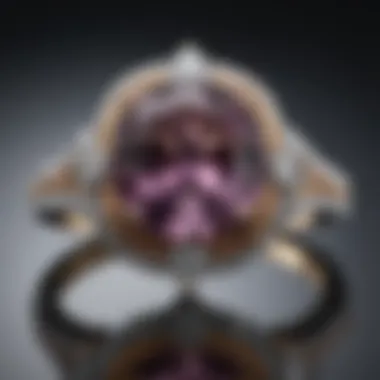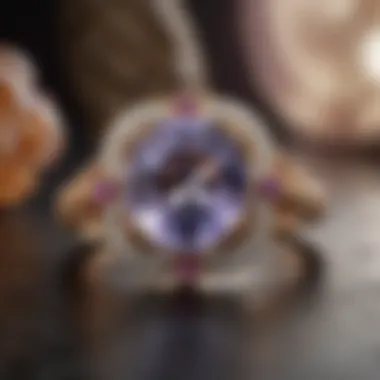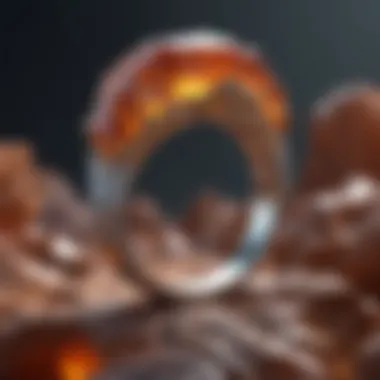Discover the Allure of Poudretteite Engagement Rings


Intro
Gemstone Overview
Definition and Origins
Poudretteite is a rare borate mineral first discovered in 1955 in Mont Saint-Hilaire in Quebec, Canada. This mineral occurs in a limited range of hues, primarily pink to light purple. The stone's name is derived from the Poudrette family, who owned the quarry where it was first found. Its geological formation involves unique environmental conditions, making it a true rarity on the market. Due to its scarcity, it possesses an allure that draws serious buyers into its depths.
Historical Significance
The historical footprint of poudretteite is intriguing, albeit short. Initially, it was overlooked compared to more common gemstones. However, in the late 20th century, its beauty gained recognition. Notably, in 2000, a sizable crystal was discovered, rekindling interest in the stone. This newfound recognition has transformed poudretteite into a coveted jewel for those seeking something distinct in the realm of fine jewelry. Collectors now see it as an investment piece due to its limited availability.
Gemstone Properties
Hardness and Durability
Poudretteite ranks between 5.5 and 6 on the Mohs scale of hardness, indicating that while it is somewhat durable, it requires careful handling. This hardness level makes it inferior to more robust gemstones like diamonds. Jewelers often recommend protective settings to strengthen the ring and ensure longevity, especially for an engagement ring that symbolizes commitment.
Color and Clarity
The captivating colors of poudretteite can vary from a subtle pastel pink to a striking vibrant hue. When evaluating this gemstone, clarity is a notable factor. High-quality specimens exhibit transparency with few inclusions, fostering a brilliant sparkle when light interacts with the surface. This exceptional quality makes fine poudretteite prestigious among connoisseurs who appreciate its unique visual appeal.
"Poudretteite's rarity and unique attributes combine to make it a captivating choice for engagement rings, reflecting both beauty and commitment."
Choosing a poudretteite engagement ring involves careful consideration of these properties to ensure the acquisition aligns with both aesthetic desires and practical needs.
Ending
In summary, poudretteite engagement rings offer a unique blend of beauty, rarity, and historical significance. As one delves deeper into its origins, properties, and care considerations, they come to appreciate why this gemstone is so extraordinary. For enthusiasts, collectors, and jewelry designers, understanding the nuances of poudretteite is essential in navigating the ever-evolving landscape of fine jewelry.
Prologue to Poudretteite Engagement Rings
Poudretteite engagement rings stand out in the realm of fine jewelry due to their unique attributes and the rarity of the gemstone itself. As an emerging favorite among gemstone enthusiasts and collectors, these rings deserve a closer examination. Understanding the significance of poudretteite brings forth not only its aesthetic appeal but also its historical context and increasing popularity.
Understanding Poudretteite
Poudretteite is a mineral that was first discovered in the early 1960s in the Poudrette Quarry, located in Canada. The gem gained recognition for its delicate color, usually ranging from pale pink to lavender. Its chemical composition reveals a fascinating structure comprising potassium, magnesium, and aluminum silicate. This unique blend contributes to its distinct appearance and the subtle beauty it embodies. For collectors and jewelry designers alike, understanding the mineral's facets is crucial. The exquisite shades and variations capture an essence that other stones may not achieve, offering an emotional depth to engagement rings crafted with this gem.
Consumers looking for a distinctive piece often find themselves drawn to the captivating qualities of poudretteite. Beyond its looks, the gemstone presents an intimate connection to nature and geological processes, lending a deeper meaning to the rings it adorns.
The Rise of Poudretteite in Fine Jewelry
In recent years, poudretteite has witnessed a noticeable surge in popularity within the fine jewelry market. Initially, it captured the interest of a select group of collectors. However, as social media platforms proliferate and influencer culture gains traction, wider accessibility to information has peaked interest among the general public. Through platforms like Instagram and Pinterest, potential buyers can now visualize how a poudretteite engagement ring can stand apart from conventional choices, presenting both individuality and charm.
Moreover, new trends in sustainability and ethical sourcing amplify the allure of unique gemstones. Purchasing a poudretteite engagement ring not only signifies love but also showcases a commitment to supporting rare and ethically mined stones. As a result, couples searching for the perfect representation of their bond are increasingly considering options beyond traditional diamonds. The emerging awareness surrounding the gemstone combined with its undeniable beauty positions poudretteite as a leading contender in modern engagement ring selections.
"The rarity of poudretteite combined with its exquisite aesthetic makes it a unique choice for couples looking to express their individual love stories."
As buyers become more educated about the options available, they discover that a poudretteite engagement ring embodies not just a moment but a narrative that resonates with their personal values.
Geological Origins of Poudretteite
Understanding the geological origins of poudretteite is crucial for appreciating its rarity and unique appeal as an engagement ring gemstone. This section delves into the processes that led to the formation of this distinct mineral, as well as the specific locations where it has been discovered. Knowledge of its origins enhances the appreciation for its beauty and scarcity, which are central aspects for potential buyers and enthusiasts.


Formation and Discoveries
Poudretteite was first discovered in the 1960s in the Poudrette Quarry located in Mont Saint-Hilaire, Quebec, Canada. The quarry is well-known for its rich mineral deposits and unique geological formations. Poudretteite is classified as a borosilicate mineral, which means it is composed of boron, silicon, and oxygen. Its formation requires specific geological conditions, including the right temperature and pressure. This is why poudretteite is relatively rare compared to other gemstones.
Several significant discoveries of poudretteite have occurred since its initial find. Collectors and researchers alike have explored various locations seeking this elusive stone. Notably, recent finds in Myanmar have added to the stone's allure and have increased interest in the gemstone market. Each new discovery contributes to the understanding of its geological behavior, aiding in the formulation of mining and extraction techniques.
Global Locations and Availability
While poudretteite has been primarily identified in Mont Saint-Hilaire, its presence in Myanmar has broadened its geographical footprint. Other locations, such as Afghanistan and the United States, have also reported finds, though these are considerably less common.
The availability of poudretteite varies significantly. Due to its scarcity and the limited number of locations where it can be mined, it is not as readily accessible as more common gemstones, like diamonds or sapphires. Sourcing a high-quality piece requires patience and often engaging with specialized jewelers.
Physical Properties of Poudretteite
Understanding the physical properties of poudretteite is essential for both collectors and jewelry designers. The properties influence not only the gemstone's aesthetic appeal, but also its durability and suitability for various types of jewelry. Poudretteite is an intriguing stone due to its unique chemical composition and characteristic colors, which can affect its market value and desirability.
Chemical Composition
Poudretteite is primarily composed of magnesium, aluminum, and silicate, forming a complex crystal structure. Its specific formula is often denoted as [MgAl_2(SiO_4)(OH)_2], where each element contributes to its overall characteristics. The presence of hydroxyl groups plays a critical role in the durability of the gemstone, making it more resilient than some other stones. This chemical structure allows for some level of brilliance and clarity, giving it a distinct appearance that many find captivating.
The rarity of poudretteite adds to its allure. It is a cyclosilicate gemstone, which means it contains rings of silicate tetrahedra that are interconnected. This unique formation not only contributes to its overall hardness but also affects how light interacts with the stone. For potential buyers, understanding this composition assists in identifying genuine stones in a market where imitation can be prevalent.
Color Variations and Characteristics
Poudretteite is known for its delicate shades, often appearing in hues of pink, lavender, and sometimes even colorless. The variations are influenced by several factors, including impurities present during formation. These color characteristics are important when selecting a stone; the richness of the color can enhance the stone’s value.
- Pink Poudretteite: This is the most sought-after variety and tends to exhibit a soft, romantic hue.
- Lavender Variants: These can be equally stunning, providing a mystical touch to any piece of jewelry.
- Colorless Options: Although rarer, these offer exceptional clarity and can resemble diamonds under certain lighting.
A notable aspect of poudretteite is its clarity. Compared to many other gemstones, it often contains fewer inclusions. This quality makes it desirable for engagement rings, where the clarity can symbolize transparency in relationships.
It is also essential to mention the lustrous finish typically found on well-cut stones. This luster can greatly influence the perception of depth and quality. Overall, the color and clarity of a poudretteite piece are crucial considerations for buyers looking to invest in distinctive and memorable jewelry.
"The unique color and clarity traits of poudretteite make it not just a gemstone but an expression of personal taste and commitment in engagement rings."
Knowing these physical properties enables potential buyers to make informed decisions, ensuring that the investment made into a poudretteite engagement ring reflects both beauty and individuality.
Cultural Significance of Poudretteite
The cultural significance of poudretteite cannot be overstated. This gemstone, with its unique properties and aesthetic appeal, plays a profound role in various cultural contexts. Understanding its historical associations and symbolic meanings enhances its appeal to collectors, enthusiasts, and individuals seeking exceptional engagement rings.
Historical Context
Poudretteite's journey into the gemstone market began in the 1980s when it was first discovered in the Poudrette Quarry, located in Canada. Since then, this stone has captivated the interest of gem collectors and jewelry designers. Its rarity—derived from limited geological deposits—elevates it to a status akin to that of diamonds and other precious stones. Historically, various societies have fawned over unique gemstones, with every stone often narrating its own story. Poudretteite is no exception.
For centuries, gemstones have been used in jewelry to signify wealth, power, and emotional connection. While less recognized in early history compared to rubies or sapphires, poudretteite is ascending in stature. Its narrative is still relatively fresh but is indelibly linked to the idea of discovery and the passion for rare beauty.
Symbolism in Engagement Rings
When it comes to engagement rings, gemstones often carry significant symbolism. Poudretteite symbolizes rarity, love, and commitment. Couples who choose this stone for their engagement ring often want something more than traditional options offer. Choosing a poudretteite ring can signify a unique bond and a love that stands apart from the norm.
In addition, the gentle pink hues of some varieties of poudretteite often evoke feelings of tenderness and affection. These emotional undercurrents intertwined with its mineral composition make it an attractive choice for those seeking to convey deeper meanings through their choice of jewelry.
"Love is like a rare gemstone, a unique ocurrence of beauty and strength."


Moreover, the increasing awareness and admiration for ethically sourced gemstones add another layer to its cultural significance. By choosing a poudretteite engagement ring known for its ethical origins, couples demonstrate a commitment not just to each other, but to responsible consumerism as well. This conscientious approach enhances the importance of the choice, reflecting ideals of sustainability and social responsibility.
Buying Considerations for Poudretteite Rings
Understanding the buying considerations for poudretteite rings is essential for individuals who seek these unique and rare gemstones. Poudretteite stands apart, not only because of its alluring beauty but also because of its scarcity. This makes informed purchasing choices crucial. Awareness of quality, ethical sourcing, and certification enhances the buyer’s experience and protects their investment. Here, we will elaborate on the different aspects that contribute to a satisfactory purchase of poudretteite engagement rings.
Evaluating Quality
Evaluating the quality of poudretteite is pivotal when selecting an engagement ring. Since this gem is rare, the quality differs significantly among individual stones. Key factors to assess include:
- Clarity: The fewer inclusions and blemishes a stone has, the higher its quality. Look for stones that exhibit minimal internal flaws.
- Color: Poudretteite is best known for its soft pink and lavender hues. The tone should be even, with deeper colors usually commanding higher prices.
- Cut: A well-cut stone maximizes brilliance and light reflection. The geometry of the stone influences its overall appearance.
- Size: While size does matter to some extent, quality should take precedence. A smaller, stunning stone might far surpass a larger, poorly executed one.
This assessment not only ensures value for money but also helps in identifying a ring that will stand the test of time in terms of both durability and aesthetic appeal.
Ethical Sourcing and Certification
It is increasingly important to consider the ethical sourcing of gemstones. Poudretteite should be sourced from reputable dealer and certified origins. This is to guarantee that the mining processes conform to humane and sustainable practices. Buyers should look for, or request, responsible sourcing practices, ensuring that their purchase does not contribute to environmental degradation or exploitative labor.
Certifications enhance the legitimacy of a purchase. An authentic gemstone may come with a certificate from recognized laboratories, such as the Gemological Institute of America (GIA). This certification confirms the gem’s quality, origin, and treatments it may have undergone. Advantages of certification include:
- Peace of Mind: Knowing that the stone is authentic reduces anxiety about potential fraud in such an investment.
- Resale Value: Certified stones often hold their value better. In the case of resale, the certification can prove advantageous.
Caring for Poudretteite Jewelry
Caring for poudretteite jewelry is crucial for maintaining its natural beauty and ensuring its longevity. As a gem of rare origin and elegant appeal, the proper treatment can significantly enhance its allure. Knowledge of suitable care, cleaning, and storage practices will not only preserve the gemstone's appearance but will also sustain its value over time. The following sections will delve into specific methods for cleaning and storing your poudretteite jewelry, making it an enjoyable part of your jewelry collection.
Cleaning Techniques
Proper cleaning is essential when maintaining graft with the natural properties of poudretteite. Although it is a moderately durable stone, it still requires gentle handling to avoid scratches or damage. Here are some effective techniques for cleaning poudretteite:
- Gentle Soap Solution: Mix a few drops of mild dish soap with warm water. Avoid harsh chemicals or abrasives. Soak the ring briefly, then use a soft brush to remove any dirt or grime.
- Soft Cloth Drying: After washing the ring, use a clean, lint-free cloth to dry it. Pat dry carefully, avoiding vigorous rubbing that can cause microscopic scratches.
- Avoid Ultrasonic Cleaners: Ultrasonic cleaners can be too strong for delicate gemstones. It is best to avoid them to prevent potential harm.
Taking time to clean your jewelry properly ensures that its sparkle remains intact and that its surface does not suffer from wear and tear.
Storage Recommendations
Proper storage for poudretteite jewelry protects it from damage and maintains its beauty. The right environment minimizes exposure to elements that could affect its color or structure:
- Soft Pouches: Store each piece in a soft cloth pouch to protect from scratches when not worn. Avoid placing multiple pieces together.
- Cool, Dry Environment: Keep your jewelry in a cool and dry place. High humidity or extreme temperatures may lead to changes in the stone's appearance over time.
- Avoid Direct Sunlight: Prolonged exposure to sunlight can weaken certain color variations of poudretteite, thus it is advisable to store your pieces away from direct sunlight.
By implementing these cleaning and storage strategies, you can ensure that your poudretteite jewelry remains a timeless piece, reflecting its charm and rarity. With appropriate care, it can continue to captivate not only you as the owner but also anyone who admires its unique beauty.
Poudretteite in Comparison with Other Gemstones
When discussing poudretteite engagement rings, it is crucial to understand how this rare gemstone compares to more established stones like diamond, sapphire, and emerald. Poudretteite stands out not only for its beauty but also for its scarcity and specific properties that might appeal to enthusiasts and collectors alike.
Rarity Compared to Popular Stones
Poudretteite is one of the rarest gemstones currently known. Its initial discovery occurred in the 1960s in Mont Saint-Hilaire, Quebec. For a long time, the number of quality stones remained extremely limited.
Unlike diamonds, which are harvested in large quantities across various regions, the supply of poudretteite is minimal. Its rarity contributes significantly to its allure, particularly for those seeking something genuinely unique.
- Scarcity: Poudretteite is much more elusive than gems like rubies or amethysts.
- Market Demand: Given its limited availability, demand often surpasses what is available.
- Value: Because of its unique qualities, the worth of poudretteite can be higher than more readily available gemstones.


This differentiation appeals to buyers looking for something that cannot be easily replicated—a trait that increases its desirability.
Durability and Wearability
In terms of hardness, poudretteite has a rating of about 5.5 to 6 on the Mohs scale. This indicates it is not as tough as diamonds, which rank a perfect 10. It requires some consideration regarding everyday wear, particularly for engagement rings which are often subject to harsh conditions.
Nonetheless, its beauty and unique characteristics can outweigh the durability drawbacks for many. Here are a few key points to consider:
- Care Recommendations: Given its hardness, care must be taken to avoid scratching or chipping.
- Setting Recommendations: Using secure settings can help protect the stone from damage.
- Occasional Wear: While it might not be suitable for everyday use, many choose to wear superbly crafted poudretteite rings for special occasions.
Ultimately, while poudretteite may not be the most durable choice available, its beauty and rarity often sway purchasing decisions for those who value uniqueness over practicality.
"Poudretteite offers a distinct combination of rarity and charm, capturing the imagination of gemstone enthusiasts everywhere."
Setting Styles for Poudretteite Engagement Rings
Poudretteite engagement rings are attracting significant attention from those in the market for unique and striking pieces. The setting style plays a crucial role in enhancing the beauty and appeal of this rare gemstone. A thoughtfully chosen setting can highlight the stone's distinct color and clarity while also reflecting the wearer's personal style. This section discusses popular design trends and custom options available for those contemplating a poudretteite engagement ring.
Popular Design Trends
There is a growing interest in modern and vintage designs when it comes to setting styles for poudretteite engagement rings. Here are a few key trends capturing attention:
- Mixed Metals: Continuously favored, mixed metal settings blend gold, silver, or platinum to create a dynamic visual effect. This approach enhances the unique color of poudretteite, allowing it to stand out.
- Halo Designs: A halo setting consists of smaller gemstones surrounding the main stone. This design enhances the perceived size of the poudretteite while adding extra sparkles through the surrounding stones. Common choices for halo settings include diamonds and sapphires.
- Three-Stone Settings: This style celebrates past, present, and future, making it highly symbolic. A central poudretteite stone framed by two complementary stones creates a stunning visual impact.
- Solitaire Designs: A timeless choice, the solitaire setting features a single poudretteite stone set on a simple band. This option allows for maximum visibility of the stone’s color and clarity, making it an elegant choice for those desiring a classic look.
These trends showcase the versatility of poudretteite and its potential to fit various aesthetic preferences.
Custom Design Options
When choosing a setting for a poudretteite engagement ring, custom design options provide an opportunity for personalization. Custom designs allow the buyers to express individual taste and creativity. Here are some considerations for custom settings:
- Choosing the Shape: Poudretteite is available in various shapes, including round, oval, and cushion. Custom settings can be designed around the specific shape of the stone, ensuring a perfect fit and unique appearance.
- Incorporating Meaningful Symbols: Buyers often wish to embed symbols of personal significance into the design. Custom engravings or unique patterns can make the ring even more special.
- Alternative Gemstones: There is often a desire to combine poudretteite with other stones that hold meaning, such as birthstones or stones representing milestones. Custom designs can incorporate these elements seamlessly.
- Design Consultations: Working with a skilled jeweler during the design process allows for valuable input. Jewelers can provide insights into how various settings will affect the overall aesthetics and durability of the ring.
The allure of custom design options lies in their ability to transform a beautiful gemstone into a cherished piece of personal art, reflecting the unique story of those who wear it.
"A setting is not just a foundation; it is the essence of how a gemstone is perceived."
The Future of Poudretteite in Gemstone Market
The role of poudretteite in the gemstone market continues to evolve, reflecting shifts in consumer preferences as well as broader market trends. This gemstone's rarity and unique aesthetic attributes promise considerable potential for growth. Buyers increasingly seek out stones that not only signify personal sentiment but also stand out due to their distinctiveness. Poudretteite engagement rings offer that allure, appealing to those who appreciate both beauty and individuality.
As consumer awareness grows, the demand for rare gemstones is expected to rise. Poudretteite, with its limited availability, is well-positioned to capture the attention of a discerning clientele.
Market Trends and Predictions
Currently, the gemstone market is witnessing a resurgence in interest for rare stones. More buyers are gravitating toward unique and lesser-known options, rather than following traditional trends. Poudretteite's unique hues and enticing color variations place it squarely in the crosshairs of this evolution.
Predictions suggest that over the next few years, prices for rare gemstones, including poudretteite, may increase significantly, driven by heightened demand and limited supply. Collectors and investors are gearing up for more than just aesthetic purchases; they view such gemstones as valuable assets.
"The market has become increasingly nuanced, favoring those gems that tell a story and stand apart from mass-produced alternatives."
Potential for Collectors and Investors
Poudretteite presents a compelling opportunity for collectors and investors alike. Its rarity alone, with few stones available, means that it is already a sought-after item among serious collectors. As the visibility of this gemstone grows within high-end markets, its investment potential becomes clearly defined.
Several factors make poudretteite a wise investment choice:
- Rarity: The limited number of high-quality stones enhances its value, making every piece unique.
- Market Visibility: Increased awareness through social media and exhibitions contributes to broader interest.
- Cultural Significance: As consumers seek meaningful purchases, the stone's history and uniqueness add intrinsic value.
Those looking to invest in gemstones should consider monitoring the market dynamics surrounding poudretteite. With careful attention to quality and sourcing, savvy investors can capitalize on this emerging market.



